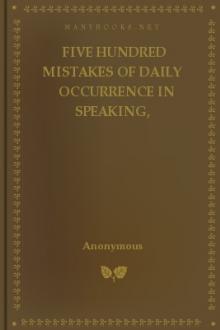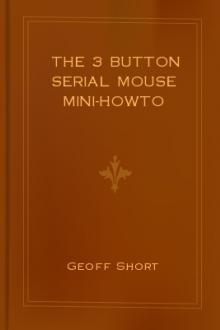The Elements of Drawing, John Ruskin [ebook reader with built in dictionary txt] 📗

- Author: John Ruskin
- Performer: -
Book online «The Elements of Drawing, John Ruskin [ebook reader with built in dictionary txt] 📗». Author John Ruskin
[51] That is to say, local color inherent in the object. The gradations of color in the various shadows belonging to various lights exhibit form, and therefore no one but a colorist can ever draw forms perfectly (see Modern Painters, vol. iv. chap. iii. at the end); but all notions of explaining form by superimposed color, as in architectural moldings, are absurd. Color adorns form, but does not interpret it. An apple is prettier because it is striped, but it does not look a bit rounder; and a cheek is prettier because it is flushed, but you would see the form of the cheek bone better if it were not. Color may, indeed, detach one shape from another, as in grounding a bas-relief, but it always diminishes the appearance of projection, and whether you put blue, purple, red, yellow, or green, for your ground, the bas-relief will be just as clearly or just as imperfectly relieved, as long as the colors are of equal depth. The blue ground will not retire the hundredth part of an inch more than the red one.
[52] See, however, at the close of this letter, the notice of one more point connected with the management of color, under the head "Law of Harmony."
[53] See farther, on this subject, Modern Painters, vol. iv. chap. viii. § 6.
[54] See Note 7 in Appendix I.
[55] "In general, throughout Nature, reflection and repetition are peaceful things, associated with the idea of quiet succession in events; that one day should be like another day, or one history the repetition of another history, being more or less results of quietness, while dissimilarity and non-succession are results of interference and disquietude. Thus, though an echo actually increases the quantity of sound heard, its repetition of the note or syllable gives an idea of calmness attainable in no other way; hence also the feeling of calm given to a landscape by the voice of a cuckoo."
[56] This is obscure in the rude wood-cut, the masts being so delicate that they are confused among the lines of reflection. In the original they have orange light upon them, relieved against purple behind.
[57] The cost of art in getting a bridge level is always lost, for you must get up to the height of the central arch at any rate, and you only can make the whole bridge level by putting the hill farther back, and pretending to have got rid of it when you have not, but have only wasted money in building an unnecessary embankment. Of course, the bridge should not be difficultly or dangerously steep, but the necessary slope, whatever it may be, should be in the bridge itself, as far as the bridge can take it, and not pushed aside into the approach, as in our Waterloo road; the only rational excuse for doing which is that when the slope must be long it is inconvenient to put on a drag at the top of the bridge, and that any restiveness of the horse is more dangerous on the bridge than on the embankment. To this I answer: first, it is not more dangerous in reality, though it looks so, for the bridge is always guarded by an effective parapet, but the embankment is sure to have no parapet, or only a useless rail; and secondly, that it is better to have the slope on the bridge and make the roadway wide in proportion, so as to be quite safe, because a little waste of space on the river is no loss, but your wide embankment at the side loses good ground; and so my picturesque bridges are right as well as beautiful, and I hope to see them built again some day instead of the frightful straight-backed things which we fancy are fine, and accept from the pontifical rigidities of the engineering mind.
[58] I cannot waste space here by reprinting what I have said in other books; but the reader ought, if possible, to refer to the notices of this part of our subject in Modern Painters, vol. iv. chap xvii.; and Stones of Venice, vol. iii. chap. i. § 8.
[59] If you happen to be reading at this part of the book, without having gone through any previous practice, turn back to the sketch of the ramification of stone pine, Fig. 4, p. 17, and examine the curves of its boughs one by one, trying them by the conditions here stated under the heads A and B.
[60] The reader, I hope, observes always that every line in these figures is itself one of varying curvature, and cannot be drawn by compasses.
[61] I hope the reader understands that these wood-cuts are merely facsimiles of the sketches I make at the side of my paper to illustrate my meaning as I write—often sadly scrawled if I want to get on to something else. This one is really a little too careless; but it would take more time and trouble to make a proper drawing of so odd a boat than the matter is worth. It will answer the purpose well enough as it is.
[62] Imperfect vegetable form I consider that which is in its nature dependent, as in runners and climbers; or which is susceptible of continual injury without materially losing the power of giving pleasure by its aspect, as in the case of the smaller grasses. I have not, of course, space here to explain these minor distinctions, but the laws above stated apply to all the more important trees and shrubs likely to be familiar to the student.
[63] There is a very tender lesson of this kind in the shadows of leaves upon the ground; shadows which are the most likely of all to attract attention, by their pretty play and change. If you examine them, you will find that the shadows do not take the forms of the leaves, but that, through each interstice, the light falls, at a little distance, in the form of a round or oval spot; that is to say, it produces the image of the sun itself, cast either vertically or obliquely, in circle or ellipse according to the slope of the ground. Of course the sun's rays produce the same effect, when they fall through any small aperture: but the openings between leaves are the only ones likely to show it to an ordinary observer, or to attract his attention to it by its frequency, and lead him to think what this type may signify respecting the greater Sun; and how it may show us that, even when the opening through which the earth receives light is too small to let us see the Sun Himself, the ray of light that enters, if it comes straight from Him, will still bear with it His image.
[64] In the smaller figure (32), it will be seen that this interruption is caused by a cart coming down to the water's edge; and this object is serviceable as beginning another system of curves leading out of the picture on the right, but so obscurely drawn as not to be easily represented in outline. As it is unnecessary to the explanation of our point here, it has been omitted in the larger diagram, the direction of the curve it begins being indicated by the dashes only.
[65] Both in the Sketches in Flanders and Germany.
[66] If you happen to meet with the plate of Dürer's representing a coat-of-arms with a skull in the shield, note the value given to the concave curves and sharp point of the helmet by the convex leafage carried round it in front; and the use of the blank white part of the shield in opposing the rich folds of the dress.
[67] Turner hardly ever, as far as I remember, allows a strong light to oppose a full dark, without some intervening tint. His suns never set behind dark mountains without a film of cloud above the mountain's edge.
[68]"A prudent chief not always must display
His powers in equal ranks and fair array,
But with the occasion and the place comply,
Conceal his force; nay, seem sometimes to fly.
Those oft are stratagems which errors seem,
Nor is it Homer nods, but we that dream."
Essay on Criticism.
[69] I am describing from an MS., circa 1300, of Gregory's Decretalia, in my own possession.
[70] One of the most wonderful compositions of Tintoret in Venice, is little more than a field of subdued crimson, spotted with flakes of scattered gold. The upper clouds in the most beautiful skies owe great part of their power to infinitude of divisions; order being marked through this division.
[71] I fully believe that the strange gray gloom, accompanied by considerable power of effect, which prevails in modern French art, must be owing to the use of this mischievous instrument; the French landscape always gives me the idea of Nature seen carelessly in the dark mirror, and painted coarsely, but scientifically, through the veil of its perversion.
[72] Various other parts of this subject are entered into, especially in their bearing on the ideal of painting, in Modern Painters, vol. iv. chap. iii.
[73] In all the best arrangements of color, the delight occasioned by their mode of succession is entirely inexplicable, nor can it be reasoned about; we like it just as we like an air in music, but cannot reason any refractory person into liking it, if they do not: and yet there is distinctly a right and a wrong in it, and a good taste and bad taste respecting it, as also in music.
[74] "Puseyism" was unknown in the days when this drawing was made; but the kindly and helpful influences of what may be called ecclesiastical sentiment, which, in a morbidly exaggerated condition, forms one of the principal elements of "Puseyism,"—I use this word regretfully, no other existing which will serve for it,—had been known and felt in our wild northern districts long before.
ILLUSTRATIVE NOTES.
Note 1, p. 42.—"Principle of the stereoscope."
247. I am sorry to find a notion current among artists, that they can, in some degree, imitate in a picture the effect of the stereoscope, by confusion of lines. There are indeed one or two artifices by which, as stated in the text, an appearance of retirement or projection may be obtained, so that they partly supply the place of the stereoscopic effect, but they do not imitate that effect. The principle of the human sight is simply this:—by means of our two eyes we literally see everything from two places at once; and, by calculated combination, in the brain, of the facts of form so seen, we arrive at conclusions respecting the distance and shape of the object, which we could not otherwise have reached. But it is just as vain to hope to paint at once the two views of the object as seen from these two places, though only an inch and a half distant from each other, as it would be if they were a mile and a half distant from each other. With the right eye you see one view of





Comments (0)